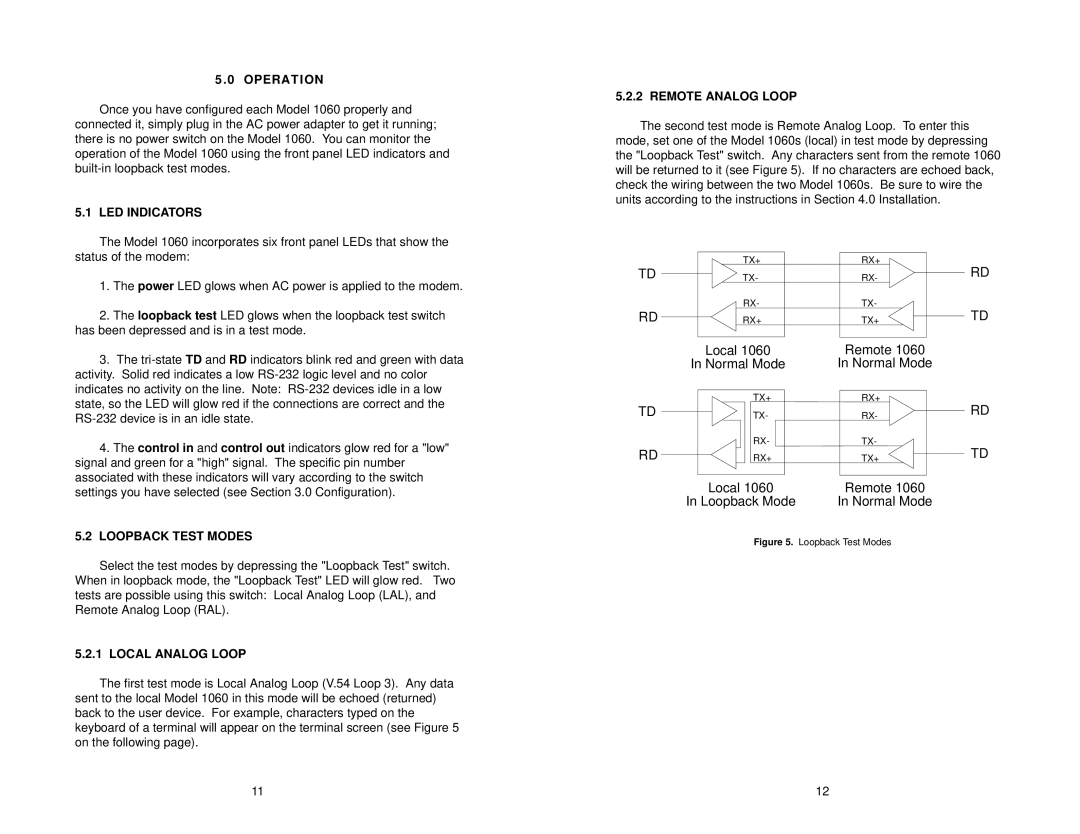
5.0 OPERATION
Once you have configured each Model 1060 properly and
connected it, simply plug in the AC power adapter to get it running; there is no power switch on the Model 1060. You can monitor the operation of the Model 1060 using the front panel LED indicators and
5.1 LED INDICATORS
The Model 1060 incorporates six front panel LEDs that show the status of the modem:
1.The power LED glows when AC power is applied to the modem.
2.The loopback test LED glows when the loopback test switch has been depressed and is in a test mode.
3.The
4.The control in and control out indicators glow red for a "low" signal and green for a "high" signal. The specific pin number associated with these indicators will vary according to the switch settings you have selected (see Section 3.0 Configuration).
5.2LOOPBACK TEST MODES
Select the test modes by depressing the "Loopback Test" switch.
When in loopback mode, the "Loopback Test" LED will glow red. Two tests are possible using this switch: Local Analog Loop (LAL), and Remote Analog Loop (RAL).
5.2.1 LOCAL ANALOG LOOP
The first test mode is Local Analog Loop (V.54 Loop 3). Any data sent to the local Model 1060 in this mode will be echoed (returned) back to the user device. For example, characters typed on the keyboard of a terminal will appear on the terminal screen (see Figure 5 on the following page).
5.2.2 REMOTE ANALOG LOOP
The second test mode is Remote Analog Loop. To enter this mode, set one of the Model 1060s (local) in test mode by depressing the "Loopback Test" switch. Any characters sent from the remote 1060 will be returned to it (see Figure 5). If no characters are echoed back, check the wiring between the two Model 1060s. Be sure to wire the units according to the instructions in Section 4.0 Installation.
|
|
|
|
|
|
| TX+ |
|
| RX+ |
|
|
| RD | ||||||||
TD |
|
|
|
|
| TX- |
|
| RX- |
|
|
|
| |||||||||
|
|
|
|
|
|
|
|
| ||||||||||||||
|
|
|
|
|
|
| RX- |
|
| TX- |
|
|
| TD | ||||||||
RD |
|
|
|
|
|
| RX+ |
|
| TX+ |
|
|
|
| ||||||||
|
|
|
|
|
|
|
|
|
| |||||||||||||
|
|
|
|
|
|
|
|
|
|
|
|
|
|
|
|
|
|
|
|
|
|
|
|
|
| Local 1060 |
| Remote 1060 |
|
| |||||||||||||||
|
| In Normal Mode | In Normal Mode |
|
| |||||||||||||||||
|
|
|
|
|
|
|
|
|
|
|
|
|
|
| ||||||||
|
|
|
|
|
|
|
|
| TX+ |
|
| RX+ |
|
| RD | |||||||
TD |
|
|
|
|
|
|
| TX- |
|
|
| RX- |
|
|
|
| ||||||
|
|
|
|
|
|
|
|
|
|
|
| |||||||||||
|
|
|
|
|
|
|
|
| RX- |
|
| TX- |
|
| TD | |||||||
RD |
|
|
|
|
|
|
|
| RX+ |
|
| TX+ |
|
|
|
| ||||||
|
|
|
|
|
|
|
|
|
|
|
|
| ||||||||||
|
|
|
|
|
|
|
|
|
|
|
|
|
|
|
|
|
|
|
|
|
|
|
|
|
| Local 1060 |
| Remote 1060 |
|
| |||||||||||||||
|
| In Loopback Mode | In Normal Mode |
|
| |||||||||||||||||
Figure 5. Loopback Test Modes
11 | 12 |
